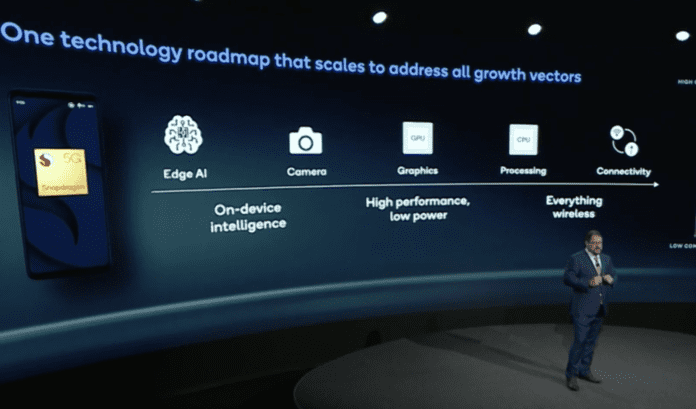Diversification and the market moving towards mobile make “the time of Qualcomm right now”
Qualcomm CEO Cristiano Amon’s message to investors at an event in New York City today was crystal clear. “This is the time of Qualcomm right now. We’re truly diversifying. The market is really moving towards our technology.”
Amon and CTO James Thomspon reiterated in their presentations that the company’s technology roadmap applies to all growth opportunities it’s tracking, many of which hinge on the proliferation of connected internet of things (IoT) devices feeding data over 5G to intelligent edge computing infrastructure.
Citing growth opportunities in mobile, computing, RF front end, automotive, artificial intelligence (AI) and IoT, Amon said, “We see the opportunity to address a $700 billion…market in the next decade. This company can no longer be defined by a single market and a single end customer.” And tying together numerous technological trends that rely on both centralized and distributed cloud computing—a segment growing at more than 30% year-over-year—Amon said, “If you believe in the growth of the cloud, you believe in the Qualcomm growth plan.”
Specific to the roadmap, Amon said, “We have one technology roadmap that is scaled to address all growth vectors. The reason is because mobile is winning.” Company DNA around high-performance, low-power computing, on-device intelligence, wireless, AI, signal processing, camera, graphics, sensors, and more “will scale to support every single device at the edge. That has been true as we look at the performance of the business as the diversification starts to change scale.”
Thompson reflected on Qualcomm’s work around CDMA for voice calling and EVDO for mobile internet. He said the company was thinking about “What is going to generate use cases that are interesting. We were trying to imagine what the smartphone would be.” That led to work on cameras, graphics, audio, video, modems (of course), and other sub-technologies that are now contained in feature-rich smartphones. “We started getting involved in all of these different things that we thought would drive data and drive the wireless internet.”
In terms of how this approach will enable Qualcomm to scale its technology roadmap into new areas, Thompson gave the example of the company’s work on cameras. While smartphone cameras use a different type of image processing than vehiclular cameras, the point remains that cameras are an essential part of modern mobile devices and automotive systems. Similarly, Qualcomm’s XR initiatives involve lots of work around graphics and rendering that is applicable elsewhere to it’s work in PCs. The future, Thompson said, is “about extending that technology roadmap [that] came out of mobile…into the intelligent edge.”
To Amon’s comment on a $700 total addressable market in a decade, that’s up from a $100 billion TAM today. In the nearer-term, Qualcomm today outlined its new three-year financial targets. QCT revenues are expected to grow at a compound annual growth rate in the mid-teens with an operating margin of 30%-plus by 2024; this includes handset, RFFE, automotive and IoT revenues. Licensing arm QTL is “expected to maintain its current revenue scale and margin profile,” according to the company.
Automotive has been a huge growth story for Qualcomm and the company, in its updated financials, expects revenues to hit $3.5 billion in five years and $8 billion in a decade. Ahead of Amon’s Investor Day presentation, Qualcomm announced it’s working with BMW Group on advanced driver-assistance systems (ADAS) and automated driving (AD) platforms. Building on an existing collaboration, BMW’s autonomy features will be based on the Snapdragon Ride SoC, vision perception and ADAS central compute SoC controllers managed by Qualcomm’s Car-2-Cloud services platform.
“BMW has chosen Qualcomm Technologies as our technology partner and systems solutions provider based on the company’s breadth and depth of portfolio, as well as proven expertise in compute, connectivity, computer vision, advanced semiconductors and driver assistance technologies,” BMW Group SVP of Driving Experience Nicolai Martin said in a statement. “We look forward to working in direct relationship with Qualcomm Technologies to build our next-generation ADAS/AD platform, as well as to continue delivering world-class driving experiences to our customers.”
Editor’s note: The above just scratches the surface of what was laid out during Qualcomm’s Investor Day. The growth in RF front end, outlook for millimeter wave 5G, complementary XR and metaverse visions, and other topics will be covered in these (digital) pages in the coming days.

